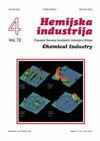葡萄酒工业废水中黄原胶的生产
IF 0.8
4区 工程技术
Q4 ENGINEERING, CHEMICAL
引用次数: 13
摘要
葡萄酒行业在酿酒的不同阶段进行了大量的清洁操作,产生了大量的废水。由于这些臭气的高有机和无机负荷以及季节性变化,在环境中处理这些臭气会带来巨大的问题。将酿酒厂废水生物转化为有价值的产品,如黄原胶,是克服环境问题的重要替代方案。在本研究中,研究了利用黄单胞菌在白葡萄酒和玫瑰酒生产不同阶段的混合废水中生产黄原胶的可能性,初始含糖量为50g/L。除了培养基参数(糖含量、总氮和可同化氮、磷、总溶解盐和表观粘度)外,还测定了原黄原胶产量和糖转化为产物的程度,以检验黄原胶生物合成的成功。在应用实验条件下,白葡萄酒和玫瑰酒生产废水的xa产量分别为20.92和30.64 g/L,糖转化率分别为40.23%和60.73%。这些实验的结果表明,在基质组成和培养条件方面对工艺进行进一步优化后,酿酒厂废水可能是工业黄原胶生产的合适原料。本文章由计算机程序翻译,如有差异,请以英文原文为准。
Xanthan production on wastewaters from wine industry
Wine industry generates large volumes of wastewaters resulting from numerous cleaning operations that occur during the different stages of winemaking. Disposal of these effluents in the environment causes huge problems due to their high organic and inorganic load and seasonal variability. The bioconversion of winery wastewaters in valuable product, such as xanthan, is an important alternative to overcome environmental problems. In this research, the possibility of xanthan production using Xanthomonas campestris on blended wastewaters from different stages of white and rose wine production with initial sugar content of 50 g/L was investigated. In addition to the media parameters (content of sugars, total and assimilable nitrogen, phosphorus, total dissolved salts and apparent viscosity), raw xanthan yield and degree of sugar conversion into product were determined in order to examine the success of xanthan biosynthesis. In applied experimental conditions, xanthan yield of 20.92 and 30.64 g/L and sugar conversion into product of 40.23 and 60.73% were achieved on wastewaters from white and rose wine production, respectively. The results of these experiments suggest that winery wastewaters, after additional optimization of the process in terms of the substrate composition and the cultivation conditions, may be a suitable raw material for industrial xanthan production.
求助全文
通过发布文献求助,成功后即可免费获取论文全文。
去求助
来源期刊

Hemijska Industrija
工程技术-工程:化工
CiteScore
1.60
自引率
11.10%
发文量
12
审稿时长
6-12 weeks
期刊介绍:
The Journal Hemijska industrija (abbreviation Hem. Ind.) is publishing papers in the field of Chemical Engineering (Transport phenomena; Process Modeling, Simulation and Optimization; Thermodynamics; Separation Processes; Reactor Engineering; Electrochemical Engineering; Petrochemical Engineering), Biochemical Engineering (Bioreactors; Protein Engineering; Kinetics of Bioprocesses), Engineering of Materials (Polymers; Metal materials; Non-metal materials; Biomaterials), Environmental Engineeringand Applied Chemistry. The journal is published bimonthly by the Association of Chemical Engineers of Serbia (a member of EFCE - European Federation of Chemical Engineering). In addition to professional articles of importance to industry, scientific research papers are published, not only from our country but from all over the world. It also contains topics such as business news, science and technology news, information on new apparatus and equipment, and articles on environmental protection.
 求助内容:
求助内容: 应助结果提醒方式:
应助结果提醒方式:


